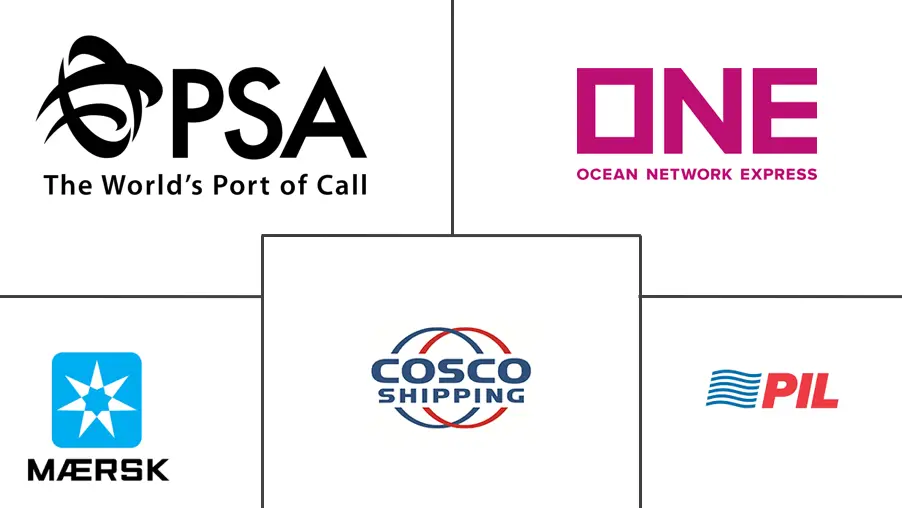Market Size of Maritime Industry in Singapore

| Study Period | 2020 - 2029 |
| Base Year For Estimation | 2023 |
| Market Size (2024) | USD 4.75 Billion |
| Market Size (2029) | USD 6.00 Billion |
| CAGR (2024 - 2029) | 4.79 % |
| Market Concentration | Medium |
Major Players
*Disclaimer: Major Players sorted in no particular order |
Singapore Maritime Market Analysis
The Maritime Industry in Singapore Market size is estimated at USD 4.75 billion in 2024, and is expected to reach USD 6 billion by 2029, growing at a CAGR of 4.79% during the forecast period (2024-2029).
Singapore has crossed the 100,000 mark for crew change carried out at the port during the ongoing coronavirus (COVID-19) pandemic, according to the Maritime and Port Authority of Singapore (MPA). Since 27 March 2020, MPA has facilitated 100,000 sign-on and sign-off crew of all nationalities from ships of different flags involving more than 5,000 companies and 6,700 ships.
Singapore is a premier global hub port and an international maritime center. Every year, 130,000 vessels enter into ports. At any given time, there are about 1,000 vessels in Singapore’s waters. More than 1,000 tonnes of cargo are handled in the ports every minute. Singapore has retained its position as the world’s second-busiest container port and the number-one bunkering port in 2020. It has also facilitated crew change for more than 80,000 seafarers amid the coronavirus (COVID-19) pandemic.
Connected to more than 600 ports in over 120 countries, Singapore’s global network allows goods to be transported efficiently anywhere. However, competition is also heating up as regional ports build more capacity and invest in new technology. Emerging technologies are transforming the nature of shipping, with automation, digitalization, and real-time data sharing improving the efficiency of port management and sea transport industries globally.
Maritime is steeped in the lifeblood of Singapore, with its illustrious relationship tracing back to its beginning as a hub for entrepot trade in the nation’s early days. After playing such a critical role in Singapore’s development from a third-world to a first-world nation within one generation, the maritime sector now continues to be a significant engine of growth for Singapore’s economy, making up 7% of the nation’s GDP and employing more than 170,000 people in various technical and commerce-related functions.
Singapore Maritime Industry Segmentation
The maritime sector is defined as consisting of the individual shipping, ports, marine, and maritime business services industries, each of which comprises a diverse array of activities. The maritime industry in Singapore is segmented by service type (water transport services, vessel leasing and rental services, cargo handling (container services, crane services, stevedoring Services, etc.), supporting service activities to water transport (shipping agencies, ship brokering services, ship management services, etc.)). The report offers market size and forecasts for the maritime industry in Singapore in value (USD) for all the above segments.
| By Services Type | |
| Water Transport Services | |
| Vessel Leasing and Rental Services | |
| Cargo Handling (Container Services, Crane Services, Stevedoring Services, etc.) | |
| Supporting Service Activities to Water Transport (Shipping Agencies, Ship Brokering Services, Ship Management Services, etc.) |
Maritime Industry in Singapore Size Summary
The Singapore maritime industry is a pivotal component of the nation's economy, serving as a global hub for maritime activities. With its strategic location and advanced infrastructure, Singapore has established itself as a leading international maritime center, facilitating a significant volume of maritime trade and operations. The industry is characterized by its extensive network, connecting over 600 ports across more than 120 countries, which enables efficient global trade. Singapore's ports are among the busiest in the world, handling a substantial amount of cargo and serving as a key transit point for vessels. The maritime sector's contribution to Singapore's GDP and employment underscores its importance, with ongoing investments in infrastructure and technology aimed at maintaining and enhancing its competitive edge.
The development of Tuas Port exemplifies Singapore's commitment to advancing its maritime capabilities. This next-generation container port is set to become the world's largest, incorporating cutting-edge technologies such as automation, digitalization, and sustainable practices. The port's design includes features to address environmental concerns, such as elevated platforms to combat rising sea levels and the use of recycled materials for reclamation. Singapore's maritime industry is also embracing green energy solutions, with initiatives to integrate renewable energy and LNG bunkering into port operations. The industry's fragmented nature, with a mix of global and regional players, continues to drive innovation and investment, ensuring Singapore remains a key player in the global maritime landscape.
Maritime Industry in Singapore Market Size - Table of Contents
-
1. MARKET INSIGHTS
-
1.1 Market Overview
-
1.2 Insights of Transshipment Trade
-
1.3 Insights on Containerized and Non-containerized Shipments
-
1.4 Insights on Bunkering Services
-
1.5 Insights on Investments in the Maritime Industry
-
1.6 Insights on the Number of Establishments and the Maritime Sector's Contribution to the Total Services Sector
-
1.7 Government Regulations and Initiatives
-
1.8 Technological Trends and Automation in Ports
-
1.9 Impact of COVID-19 on the Market (discussing short-term and long-term effects on the market)
-
-
2. MARKET SEGMENTATION (Market Size by Value)
-
2.1 By Services Type
-
2.1.1 Water Transport Services
-
2.1.2 Vessel Leasing and Rental Services
-
2.1.3 Cargo Handling (Container Services, Crane Services, Stevedoring Services, etc.)
-
2.1.4 Supporting Service Activities to Water Transport (Shipping Agencies, Ship Brokering Services, Ship Management Services, etc.)
-
-
Maritime Industry in Singapore Market Size FAQs
How big is the Maritime Industry in Singapore Market?
The Maritime Industry in Singapore Market size is expected to reach USD 4.75 billion in 2024 and grow at a CAGR of 4.79% to reach USD 6.00 billion by 2029.
What is the current Maritime Industry in Singapore Market size?
In 2024, the Maritime Industry in Singapore Market size is expected to reach USD 4.75 billion.

